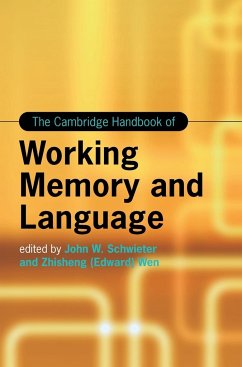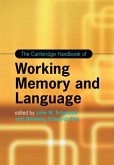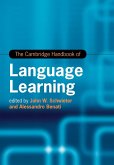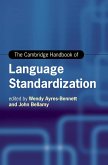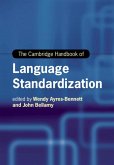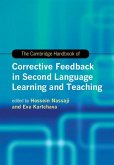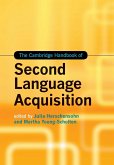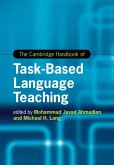The Cambridge Handbook of Working Memory and Language
Herausgeber: Schwieter, John W.; Wen, Zhisheng (Edward)
The Cambridge Handbook of Working Memory and Language
Herausgeber: Schwieter, John W.; Wen, Zhisheng (Edward)
- Gebundenes Buch
- Merkliste
- Auf die Merkliste
- Bewerten Bewerten
- Teilen
- Produkt teilen
- Produkterinnerung
- Produkterinnerung
Bringing together cutting-edge research from a global team of experts, this Handbook provides an overview of the role of working memory in first and second language acquisition, processing, impairments and training. It is essential reading for researchers and students of language sciences, language teaching and learning, and cognitive science.
Andere Kunden interessierten sich auch für
![The Cambridge Handbook of Working Memory and Language The Cambridge Handbook of Working Memory and Language]() The Cambridge Handbook of Working Memory and Language51,99 €
The Cambridge Handbook of Working Memory and Language51,99 €![The Cambridge Handbook of Language Learning The Cambridge Handbook of Language Learning]() The Cambridge Handbook of Language Learning53,99 €
The Cambridge Handbook of Language Learning53,99 €![The Cambridge Handbook of Language Standardization The Cambridge Handbook of Language Standardization]() The Cambridge Handbook of Language Standardization157,99 €
The Cambridge Handbook of Language Standardization157,99 €![The Cambridge Handbook of Language Standardization The Cambridge Handbook of Language Standardization]() The Cambridge Handbook of Language Standardization49,99 €
The Cambridge Handbook of Language Standardization49,99 €![The Cambridge Handbook of Corrective Feedback in Second Language Learning and Teaching The Cambridge Handbook of Corrective Feedback in Second Language Learning and Teaching]() The Cambridge Handbook of Corrective Feedback in Second Language Learning and Teaching49,99 €
The Cambridge Handbook of Corrective Feedback in Second Language Learning and Teaching49,99 €![The Cambridge Handbook of Second Language Acquisition The Cambridge Handbook of Second Language Acquisition]() The Cambridge Handbook of Second Language Acquisition52,99 €
The Cambridge Handbook of Second Language Acquisition52,99 €![The Cambridge Handbook of Task-Based Language Teaching The Cambridge Handbook of Task-Based Language Teaching]() The Cambridge Handbook of Task-Based Language Teaching49,99 €
The Cambridge Handbook of Task-Based Language Teaching49,99 €-
-
-
Bringing together cutting-edge research from a global team of experts, this Handbook provides an overview of the role of working memory in first and second language acquisition, processing, impairments and training. It is essential reading for researchers and students of language sciences, language teaching and learning, and cognitive science.
Hinweis: Dieser Artikel kann nur an eine deutsche Lieferadresse ausgeliefert werden.
Hinweis: Dieser Artikel kann nur an eine deutsche Lieferadresse ausgeliefert werden.
Produktdetails
- Produktdetails
- Cambridge Handbooks in Language and Linguistics
- Verlag: Cambridge University Press
- Seitenzahl: 974
- Erscheinungstermin: 1. Juli 2022
- Englisch
- Abmessung: 250mm x 175mm x 56mm
- Gewicht: 2002g
- ISBN-13: 9781108845342
- ISBN-10: 1108845347
- Artikelnr.: 62920774
- Herstellerkennzeichnung
- Libri GmbH
- Europaallee 1
- 36244 Bad Hersfeld
- gpsr@libri.de
- Cambridge Handbooks in Language and Linguistics
- Verlag: Cambridge University Press
- Seitenzahl: 974
- Erscheinungstermin: 1. Juli 2022
- Englisch
- Abmessung: 250mm x 175mm x 56mm
- Gewicht: 2002g
- ISBN-13: 9781108845342
- ISBN-10: 1108845347
- Artikelnr.: 62920774
- Herstellerkennzeichnung
- Libri GmbH
- Europaallee 1
- 36244 Bad Hersfeld
- gpsr@libri.de
1. Working memory and language: an overview of key topics
Part I. Introduction: 2. Working memory and the challenge of language
Part II. Theoretical Models and Measures: 3. The evolution of working memory and language
4. The phonological loop as a 'language learning device': an update
5. The Embedded-Processes Model and language use
6. Long-term working memory and language comprehension
7. The cognitive neuroscience of working memory and language
8. Computational models of working memory for language
9. The time-based resource sharing model of working memory for language
10. The Ease of Language Understanding Model
11. Assessing children's working memory
12. Measuring individual differences in working memory capacity and attention control and their contribution to language comprehension
Part III. Linguistic Theories and Frameworks: 13. Have grammars been shaped by working memory and if so, how?
14. Branching and working memory: a cross-linguistic approach
15. Working memory and natural syntax
16. The role of working memory in shaping syntactic dependency structures
17. Working memory in the Modular Cognition Framework
18. Short-term and working memory capacity and the language device: chunking and parsing complexity
Part IV. First Language Processing: 19. Working memory in word reading
20. The role of working memory in language comprehension and production: evidence from neuropsychology
21. Working memory and high-level text comprehension processes
22. Working memory and speech planning
23. How do novice and skilled writers engage working memory?
Part V. Bilingual Acquisition and Processing: 24. How measures of working memory relate to L2 vocabulary
25. Working memory and L2 grammar development in children
26. Working memory and L2 grammar learning among adults
27. Working memory and L2 sentence processing
28. Methodological issues in research on working memory and L2 reading comprehension
29. Working memory and second language speaking tasks
30. Working memory in second language interaction
31. Working memory and interpreting studies
32. A methodological synthesis of working memory tasks in L2 research
Part VI. Language Disorders, Interventions, and Instruction: 33. Specific learning disorders as a working memory deficit
34. A new perspective on the connection between memory and sentence comprehension in children with developmental language disorder
35. Working memory and childhood deafness
36. Working memory training in the classroom
37. Working memory and classroom learning
38. Cognitive load theory and instructional design for language learning
39. Working memory training: meta-analyses and clinical implications
Part VII. Conclusion: 40. Towards an integrated account of working memory and language
Index.
Part I. Introduction: 2. Working memory and the challenge of language
Part II. Theoretical Models and Measures: 3. The evolution of working memory and language
4. The phonological loop as a 'language learning device': an update
5. The Embedded-Processes Model and language use
6. Long-term working memory and language comprehension
7. The cognitive neuroscience of working memory and language
8. Computational models of working memory for language
9. The time-based resource sharing model of working memory for language
10. The Ease of Language Understanding Model
11. Assessing children's working memory
12. Measuring individual differences in working memory capacity and attention control and their contribution to language comprehension
Part III. Linguistic Theories and Frameworks: 13. Have grammars been shaped by working memory and if so, how?
14. Branching and working memory: a cross-linguistic approach
15. Working memory and natural syntax
16. The role of working memory in shaping syntactic dependency structures
17. Working memory in the Modular Cognition Framework
18. Short-term and working memory capacity and the language device: chunking and parsing complexity
Part IV. First Language Processing: 19. Working memory in word reading
20. The role of working memory in language comprehension and production: evidence from neuropsychology
21. Working memory and high-level text comprehension processes
22. Working memory and speech planning
23. How do novice and skilled writers engage working memory?
Part V. Bilingual Acquisition and Processing: 24. How measures of working memory relate to L2 vocabulary
25. Working memory and L2 grammar development in children
26. Working memory and L2 grammar learning among adults
27. Working memory and L2 sentence processing
28. Methodological issues in research on working memory and L2 reading comprehension
29. Working memory and second language speaking tasks
30. Working memory in second language interaction
31. Working memory and interpreting studies
32. A methodological synthesis of working memory tasks in L2 research
Part VI. Language Disorders, Interventions, and Instruction: 33. Specific learning disorders as a working memory deficit
34. A new perspective on the connection between memory and sentence comprehension in children with developmental language disorder
35. Working memory and childhood deafness
36. Working memory training in the classroom
37. Working memory and classroom learning
38. Cognitive load theory and instructional design for language learning
39. Working memory training: meta-analyses and clinical implications
Part VII. Conclusion: 40. Towards an integrated account of working memory and language
Index.
1. Working memory and language: an overview of key topics
Part I. Introduction: 2. Working memory and the challenge of language
Part II. Theoretical Models and Measures: 3. The evolution of working memory and language
4. The phonological loop as a 'language learning device': an update
5. The Embedded-Processes Model and language use
6. Long-term working memory and language comprehension
7. The cognitive neuroscience of working memory and language
8. Computational models of working memory for language
9. The time-based resource sharing model of working memory for language
10. The Ease of Language Understanding Model
11. Assessing children's working memory
12. Measuring individual differences in working memory capacity and attention control and their contribution to language comprehension
Part III. Linguistic Theories and Frameworks: 13. Have grammars been shaped by working memory and if so, how?
14. Branching and working memory: a cross-linguistic approach
15. Working memory and natural syntax
16. The role of working memory in shaping syntactic dependency structures
17. Working memory in the Modular Cognition Framework
18. Short-term and working memory capacity and the language device: chunking and parsing complexity
Part IV. First Language Processing: 19. Working memory in word reading
20. The role of working memory in language comprehension and production: evidence from neuropsychology
21. Working memory and high-level text comprehension processes
22. Working memory and speech planning
23. How do novice and skilled writers engage working memory?
Part V. Bilingual Acquisition and Processing: 24. How measures of working memory relate to L2 vocabulary
25. Working memory and L2 grammar development in children
26. Working memory and L2 grammar learning among adults
27. Working memory and L2 sentence processing
28. Methodological issues in research on working memory and L2 reading comprehension
29. Working memory and second language speaking tasks
30. Working memory in second language interaction
31. Working memory and interpreting studies
32. A methodological synthesis of working memory tasks in L2 research
Part VI. Language Disorders, Interventions, and Instruction: 33. Specific learning disorders as a working memory deficit
34. A new perspective on the connection between memory and sentence comprehension in children with developmental language disorder
35. Working memory and childhood deafness
36. Working memory training in the classroom
37. Working memory and classroom learning
38. Cognitive load theory and instructional design for language learning
39. Working memory training: meta-analyses and clinical implications
Part VII. Conclusion: 40. Towards an integrated account of working memory and language
Index.
Part I. Introduction: 2. Working memory and the challenge of language
Part II. Theoretical Models and Measures: 3. The evolution of working memory and language
4. The phonological loop as a 'language learning device': an update
5. The Embedded-Processes Model and language use
6. Long-term working memory and language comprehension
7. The cognitive neuroscience of working memory and language
8. Computational models of working memory for language
9. The time-based resource sharing model of working memory for language
10. The Ease of Language Understanding Model
11. Assessing children's working memory
12. Measuring individual differences in working memory capacity and attention control and their contribution to language comprehension
Part III. Linguistic Theories and Frameworks: 13. Have grammars been shaped by working memory and if so, how?
14. Branching and working memory: a cross-linguistic approach
15. Working memory and natural syntax
16. The role of working memory in shaping syntactic dependency structures
17. Working memory in the Modular Cognition Framework
18. Short-term and working memory capacity and the language device: chunking and parsing complexity
Part IV. First Language Processing: 19. Working memory in word reading
20. The role of working memory in language comprehension and production: evidence from neuropsychology
21. Working memory and high-level text comprehension processes
22. Working memory and speech planning
23. How do novice and skilled writers engage working memory?
Part V. Bilingual Acquisition and Processing: 24. How measures of working memory relate to L2 vocabulary
25. Working memory and L2 grammar development in children
26. Working memory and L2 grammar learning among adults
27. Working memory and L2 sentence processing
28. Methodological issues in research on working memory and L2 reading comprehension
29. Working memory and second language speaking tasks
30. Working memory in second language interaction
31. Working memory and interpreting studies
32. A methodological synthesis of working memory tasks in L2 research
Part VI. Language Disorders, Interventions, and Instruction: 33. Specific learning disorders as a working memory deficit
34. A new perspective on the connection between memory and sentence comprehension in children with developmental language disorder
35. Working memory and childhood deafness
36. Working memory training in the classroom
37. Working memory and classroom learning
38. Cognitive load theory and instructional design for language learning
39. Working memory training: meta-analyses and clinical implications
Part VII. Conclusion: 40. Towards an integrated account of working memory and language
Index.

